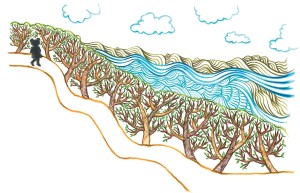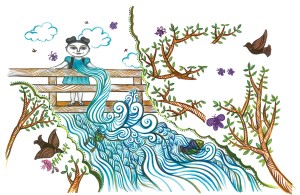![]() Jill Eisenberg is our Resident Literacy Expert. Jill began her career teaching English as a Foreign Language to second through sixth graders in Taiwan as a Fulbright Fellow. She went on to become a literacy teacher for third grade in San Jose, CA as a Teach for America corps member. She is certified in Project Glad instruction to promote English language acquisition and academic achievement. In her column she offers teaching and literacy tips for educators.
Jill Eisenberg is our Resident Literacy Expert. Jill began her career teaching English as a Foreign Language to second through sixth graders in Taiwan as a Fulbright Fellow. She went on to become a literacy teacher for third grade in San Jose, CA as a Teach for America corps member. She is certified in Project Glad instruction to promote English language acquisition and academic achievement. In her column she offers teaching and literacy tips for educators.
Note: This lesson can be done with other books, but dual language/bilingual books offer a unique opportunity to engage non-English speaking parents in the classroom and provide a way to continue rigorous discussions with their children at home regardless of English in the home. Bilingual books additionally underscore the diversity of our classroom communities and equalize parents as teachers in students’ minds.
Last week, I spoke about my experience teaching in a school where nearly 85% of my students were English Language Learners and English was not the primary language spoken at home. Using a bilingual book with a Spanish-speaking parent in the classroom is a strategy I learned teaching in San Jose, CA as a part of a parent engagement program called “Los Dichos de la Casa” by Silicon Valley YMCA.
Whether your classroom has only a few English Language Learners (ELLs) or a majority, bilingual and dual language books can encourage close reading of a text and increase accessibility of the text to ELLs. Over the next few posts, we will model how bilingual and dual language books are being used in classrooms to foster deep, critical thinking and a love of reading.
Exemplar Text: I Know the River Loves Me/ Yo Se Que El Rio Me Ama by Maya Christina Gonzalez
Guided Reading level: K
DRA level: 20
Recommended grades: 1-2
Objectives:
• Increase student academic achievement and confidence, especially among English Language Learners
• Provide meaningful ways for parents to contribute to the academic success of children
• Celebrate classroom and community diversity through the study of Latino culture and universal themes
Common Core Anchor Strands:
CCSS.ELA-Literacy.RL.1.2 Demonstrate understanding of their central message or lesson.
CCSS.ELA-Literacy.RL.2.2 Determine their central message, lesson, or moral.
CCSS.ELA-Literacy.SL.1.1 Participate in collaborative conversations with diverse partners about grade 1 topics and texts with peers and adults in small and larger groups.
CCSS.ELA-Literacy.SL.2.1 Participate in collaborative conversations with diverse partners about grade 2 topics and texts with peers and adults in small and larger groups.
Opening:
1. Introduce title of the text and the parent-volunteer as a special guest teacher. Explain to students that today the book will be read alternating in both English and Spanish.
2. Build background schema on topic of book: rivers. In doing so, students will become more invested in the topic and allow students of all levels, particularly English Language Learners, to appear as “experts” to their peers. This can be done with a mind map either as a whole class or individually—put the word “river” at the center of the board and write down what words/ideas students think about when they think about rivers. To elicit discussion, start with these questions:
• What words would you use to describe a river to someone who had never seen one?
• What are some famous rivers?
• How are rivers special to animals? To people?
• What can you do in, near, or with a river?
• What happens when people don’t take care of rivers? Why might it be important to respect rivers and other parts of nature?
3. When asking these questions, have the parent-volunteer ask them first in Spanish and call on students to answer the questions in Spanish. Even if not all of the students speak or understand Spanish, one student at the end of that question’s discussion can summarize what was said and translate it into English for the rest of the class. If students struggle to translate between languages at this age, the parent-volunteer can translate back to English.
Reading the Story:
1. As you begin reading, pause on each page so the parent-volunteer can read the Spanish portion. If possible, both the parent and you should have your own book.
2. Have pre-determined stopping points to ask about lesson of the story. Provide questions to the parent beforehand to translate into Spanish. Have the parent-volunteer read the question and elicit responses first in Spanish. Again, even if not all of the students speak or understand Spanish, one student at the end of that question’s discussion can summarize what was said and translate it into English for the rest of the class (or parent volunteer can help translate back to English if possible). Follow up by asking the same question in English and garnering answers in English.
Possible questions to ask:
• Why does the little girl visit the river?
• Why does she think the river is her best friend?
• Can we be best friends with some part of nature? When you are best friends with someone, how do you treat them?
• Why is the river so special to her?
• How does the river help the little girl?
• How does the river make the little girl feel?
• How does the little girl take care of the river? What would happen if the little girl did not take care of the river?
• What are ways people can take care of rivers (or nature)?
• Why is it important to respect nature?
• What does this book teach us about caring and respect?
After Reading:
1. Final discussion questions should be in both Spanish and English. Have the parent-volunteer read the question and elicit responses first in Spanish. Then, one student at the end of that question’s discussion can summarize what was said and translate it into English for the rest of the class. Follow up by asking the same question in English and garnering answers in English.
2. I strongly recommend a parent-led art/craft activity that is relevant to the book topic. This allows students to reflect on their own experiences and encourages parent-student bond. Activities can include writing/drawing what each student would do at the river, their favorite water activity or memory (at the beach, pool, lake, river), or why we need to take care of rivers and the environment.
3. Reflect with the class on why you read the text in English and Spanish.
4. Review what themes they learned today and can continue to use at home.











